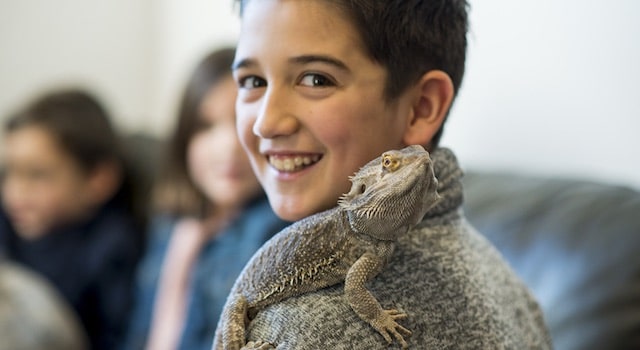
Introduction to Adopting a Rescue Bearded Dragon
Giving a rescue bearded dragon a second chance at life is one of the most rewarding experiences as reptile owner. There are so many rescue bearded dragons in need of a loving home, and they are no different than ones from a pet store or breeder. In fact, they were most likely from a breeder or pet store before being taken in as a rescue. Even if you don’t live in an area where bearded dragons are commonly kept as pets, you might be surprised to find one up for adoption, so it’s worth considering.
We are very passionate about encouraging others to adopt a rescue bearded dragon, so this article will tell you everything you need to know.
The Benefits of Adopting a Rescue Bearded Dragon
There are numerous benefits to adopting a rescue bearded dragon. Most of them were either abandoned or surrendered to a rescue organization because the previous owner could no longer care for them or they were mistreated. This usually means that they have already adjusted to domestic life and are often already comfortable with being handled. This could make them easier to bond with, especially if the previous owner already trained and socialized them.
However, that doesn’t mean that an unsocialized bearded dragon isn’t worth adopting. It’s rewarding to put patience and effort into socializing them until they eventually become comfortable with you. Remember, you might be adopting a bearded dragon that comes with a history of neglect or abuse, so it’s understandable why they could be fearful of humans.
Another benefit is that most rescues only charge a single adoption fee, which could be more affordable than buying from a pet store or breeder. Bearded dragons from reputable breeders can cost a few hundred to thousands of dollars, especially if you want a rare morph. This is true for most pet stores as well. Plus, many pet stores get their bearded dragons from animal breeding mills, which are essentially large breeding facilities that mass breed animals for profit. Little thought is given to the health and well-being of the animals being bred.
When you adopt a bearded dragon, you pay an adoption fee that supports the rescue organization so that they can continue rescuing more animals. This is way more beneficial than buying from a pet store and ultimately supporting breeding mills.
Why Rescue Bearded Dragons Make Great Pets
Rescue bearded dragons make fantastic, loving pets for various reasons. For starters, giving a rescue bearded dragon a new home where they will finally receive the love and care they deserve is incredibly fulfilling. This is a major reason why people often adopt, especially if they are experienced with adopting dogs or cats.
Rescue bearded dragons make great interactive pets, just like the ones from pet stores or breeders, and their care is no different. They are ideal for both beginner and experienced owners and are usually already socialized and comfortable with being handled. Beginners usually find it easier to bond and handle a rescue bearded dragon if this is the case.
And, of course, the costs. You might not want to support pet stores, and a reputable breeder might be too expensive, so adoption is the next best option for you. In some cases, a rescue bearded dragon might already come with an enclosure and proper setup, which will be included in the adoption fee for much less than if you were to buy everything new.
Considerations Before Adopting a Rescue Bearded Dragon
Lifelong Commitment
When you choose to adopt a rescue bearded dragon, you make the commitment to care for them for the rest of their life. Bearded dragons can live for about 10 to 15 years with proper care, making them the same long-term commitment as a dog or cat. Are you financially able to care for a bearded dragon for the next decade or two? Do you have a long-term plan to ensure that you can care for them in the event of unforeseen circumstances, such as moving homes or losing your job? These are important questions to consider before adopting a bearded dragon.
Proper Care and Setup
Furthermore, you should make sure that you can care for them properly by providing the right-sized enclosure and setup, along with feeding a healthy diet. Bearded dragons have specific care requirements that need to be met in order for them to live a healthy and happy life. Remember that they could have ended up at the rescue because of previous neglect, so they deserve the best care possible in their new home.
Health and Behavioral Challenges
Lastly, you should consider the possibility that they might have existing health issues or a challenging history that requires patience and understanding. Most rescues will inform you about their history before the adoption process, but there is still the possibility that little is known about their background or their current health.
You should also ensure that you can afford to take them to a veterinarian for regular health checks and to afford any long-term medications if they have a serious health issue, such as metabolic bone disease. If they have behavioral issues or are fearful of being handled, make sure that you have the patience to spend time training and socializing them to be comfortable around humans. This can take a lot of work, but it will all be worthwhile once they start warming up to you.
Why We Recommend Adopting a Rescue Bearded Dragon
We encourage you to adopt a bearded dragon rather than buy one from a backyard breeder or pet store because it’s usually the right thing to do. You will be supporting a rescue organization that is dedicating its time and resources to helping abandoned or mistreated animals rather than supporting animal breeding mills that only care about profit. When you adopt an animal, you are reducing the demand for bearded dragons from breeding mills and sales. In return, you get a loving and loyal pet that you gave a second chance in life too, even though they might have been abandoned or mistreated in the past.
Where to Adopt a Rescue Bearded Dragon
There are many places that commonly have rescue bearded dragons up for adoption. The first place you should start looking at is nearby rescue centers or organizations, which can be found through their online web pages or by asking for recommendations on social media.
If none of the rescues have any up for adoption, you could try seeing if a nearby large-chain pet store has any adoptable reptiles. This isn’t very commonly known, but several pet stores adopt out sick or injured animals that do not meet the requirements to be sold. Although you might have to pay a small fee, some stores will let you adopt for free.
If you still don’t have any luck, you could try looking on local rehoming sites to see if someone in your area is looking to rehome or surrender their bearded dragon. You could also try joining local rescue groups or forums where people can connect with rescue opportunities.
Conclusion
We highly recommend that you consider adopting a bearded dragon and giving them a second chance at a forever home. As you can tell from this article, adoption has numerous benefits compared to buying from a pet store or breeder. In return for your adoption efforts, you will get a loving pet that will be thankful that you decided to take them home. Bearded dragons make great pets regardless of where you get them from, whether that’s a breeder, pet store, or rescue organization. Adoption is usually the best decision a pet owner can make, whether they are a beginner or experienced.



